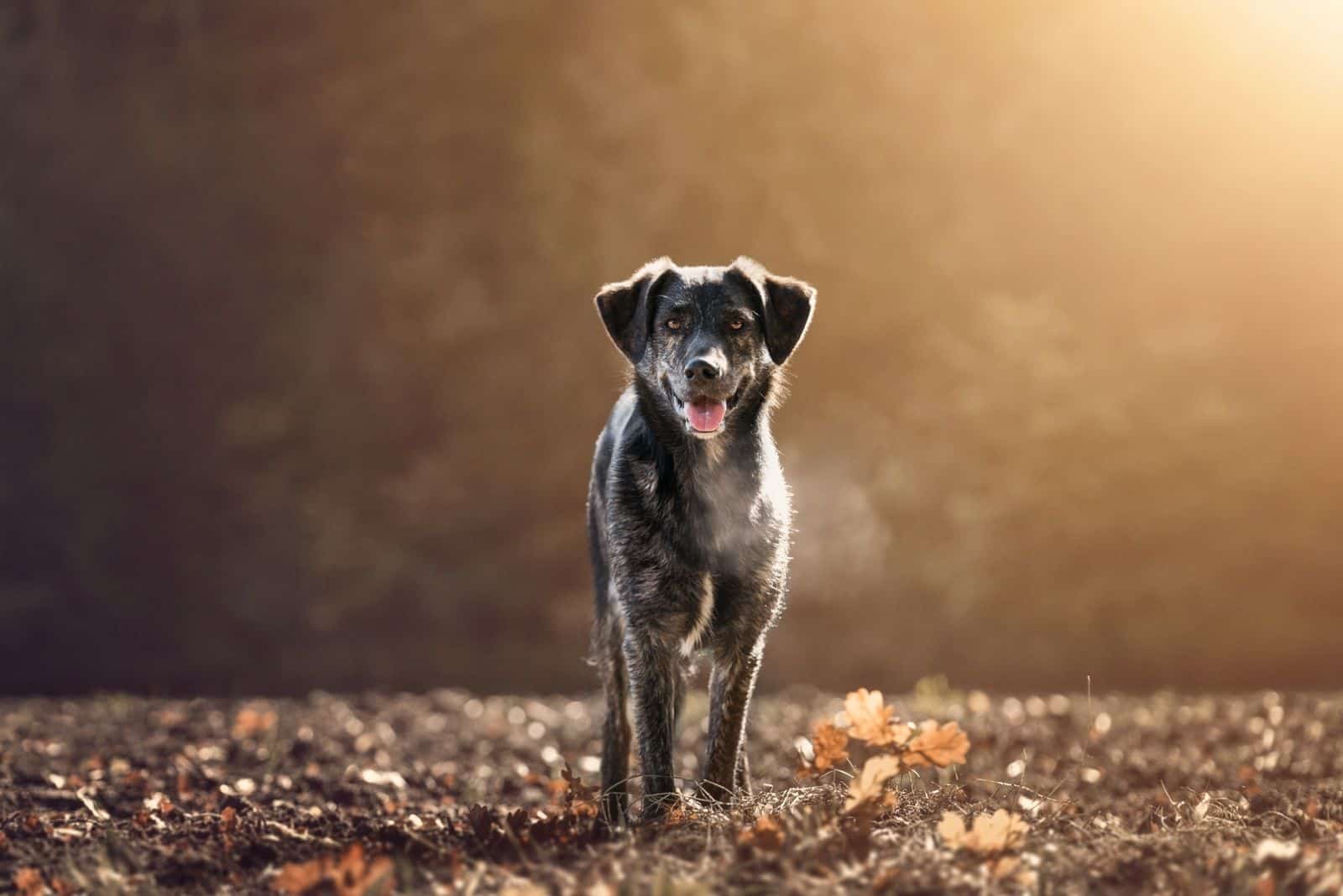What do you get when you cross two of the best working dogs in the world?
You get the German Shepherd Aussie mix!
Okay, that name needs some work. It’s just that the names of these two wonderful dog breeds don’t really lend themselves to being combined, as in the case of the Labradoodle or the Pitsky. You could end up with something as weird as the Germalian Shepherd!
This has already happened in the case of the Siberian Husky and German Shepherd mix, which is often called the Gerberian Shepsky!
Despite the problem with its name, the German Shepherd Australian Shepherd mix is a superb dog. Nobody is really sure when and where it was first bred, but it is gradually becoming recognized as a great choice for pet parents.
Want to find out more? Then, take a look at our guide to see what all the fuss is about.
The best place to begin is with an overview of each of the parent breeds separately before we move on to examine the hybrid of the two.
The German Shepherd
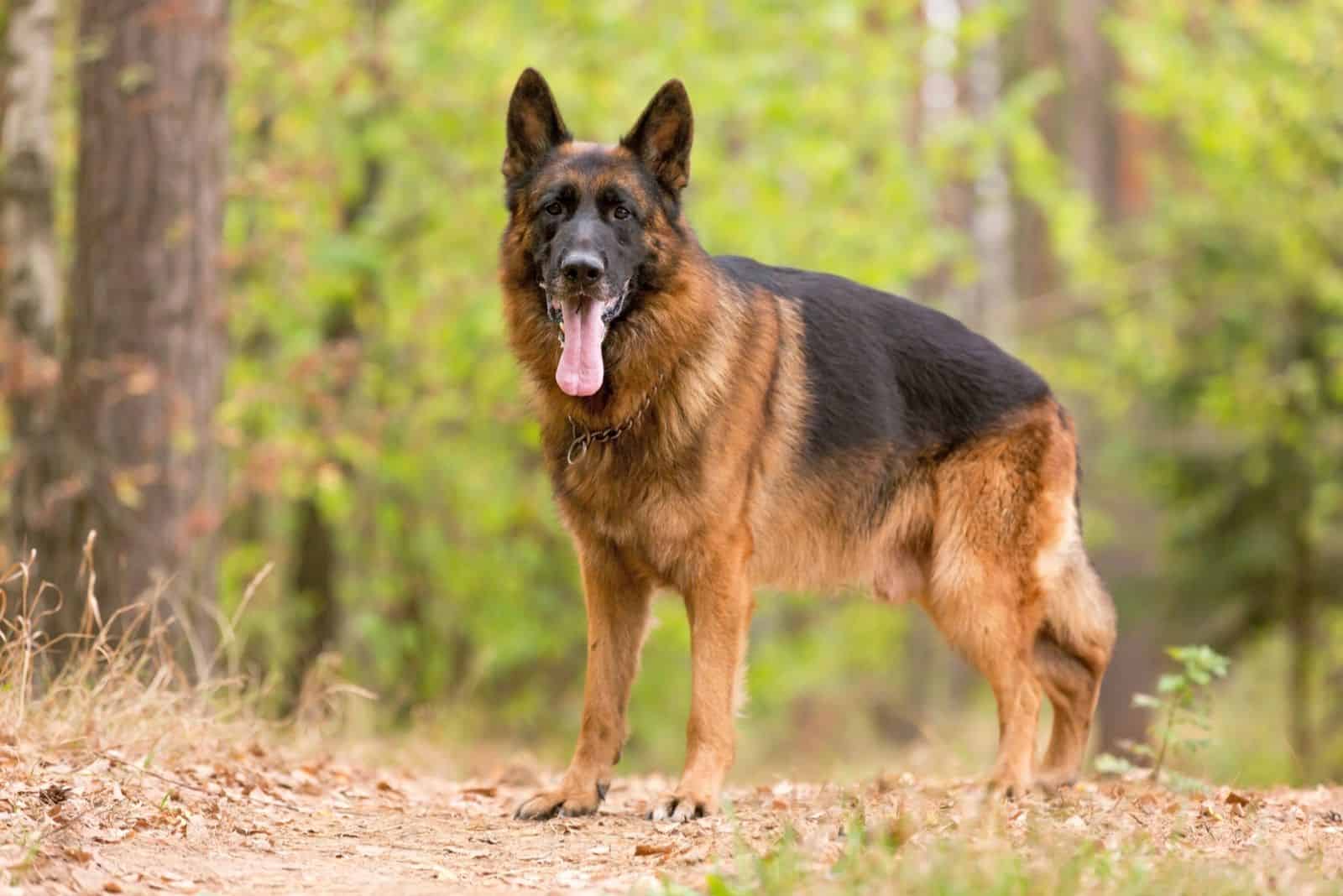
Towards the end of the 19th century, a German officer by the name of Captain Max von Stephanitz set out on a quest to produce the perfect herding dog. He did this by using a selection of the best shepherd breeds that were scattered around the German countryside, eventually creating the purebred German Shepherd dog, also known as the GSD.
This breed’s fame soon spread around the world, helped by the TV shows and movies that featured them, such as Rin Tin Tin.
It became apparent that their skills extended far beyond looking after flocks of sheep, and the GSD found roles with the military, security services, the police, and as a therapy and guide dog.
The typical German Shepherd is bred to be confident, courageous, fiercely loyal, and very affectionate towards its owners. It will guard and protect you one minute, but then be ready to play fetch or come for cuddles the next!
Unlike the Labrador or the Golden Retriever, the GSD is selective about who it loves, and it might take a while to warm up to visitors in your home.
The average female GSD stands between 22 and 24 inches at the shoulder, while males measure between 24 and 26 inches. Females usually weigh between 50 and 70 pounds, and males are generally bigger, weighing between 65 and 90 pounds.
They are excellent with children of all ages, especially when they are socialized. If the kids and the dog are raised together, they form a very strong bond. Your pup will likely guard their crib or pushchair!
German Shepherds are really smart and easy to train. They just love to learn stuff, and it makes them really happy.
In fact, they are at their happiest when given a job to do, as this provides the exercise and mental stimulation that they crave.
Most people will have seen the classic black and tan GSD, but they also come in other colors:
• Black
• Blue
• Gray
• Sable
• Liver
• Bi-color (a variation of black and tan, with a mostly black coat)
• Black & cream
• Black & silver
• Black & red
• White
Some of these are less common than others, but due to the complexities of genetics, there’s a chance that they could pop up in the hybrid pups.
The Australian Shepherd
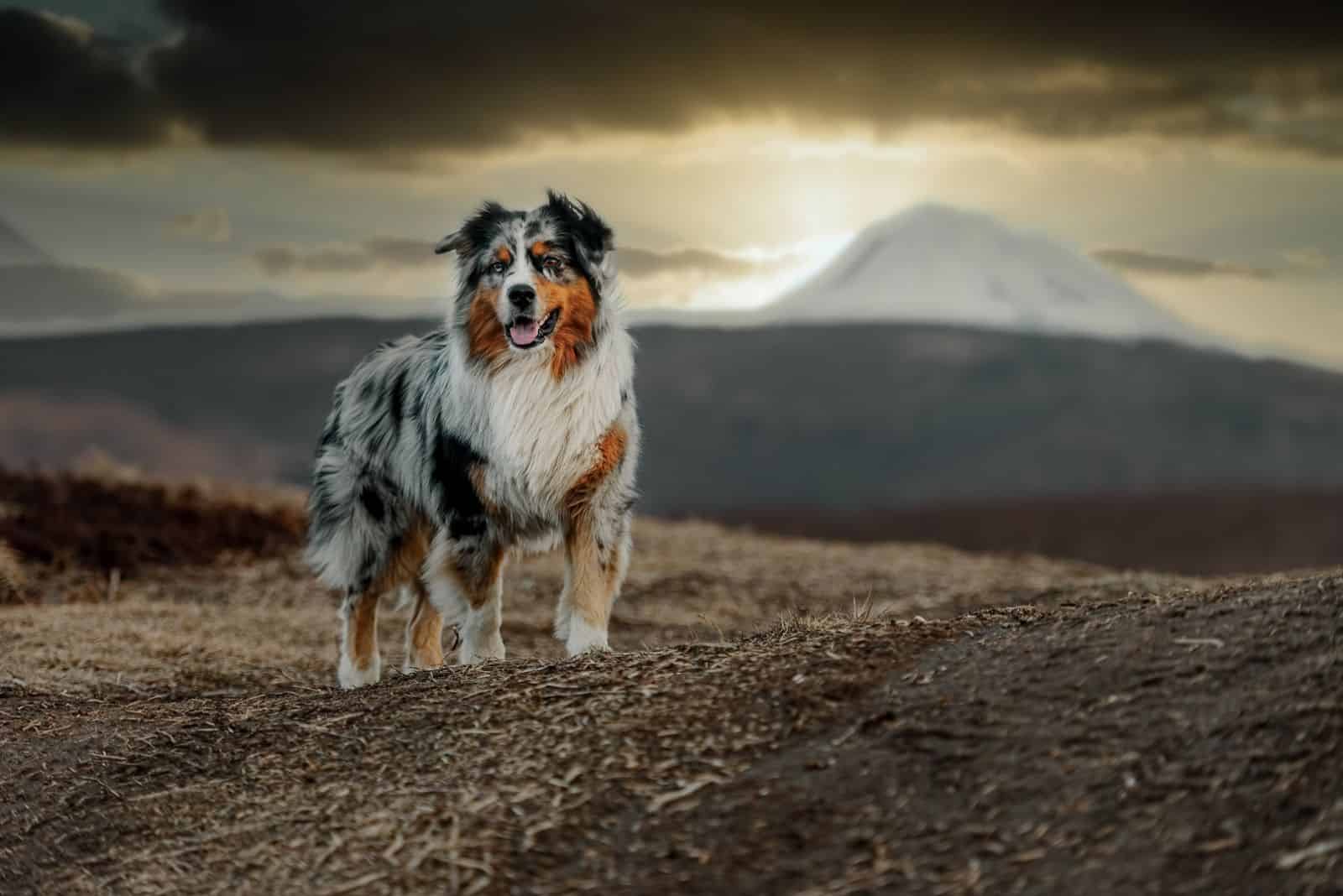
First, let’s get this straight: this dog is not from Australia!
So, why is it called the Aussie Shepherd?
To cut a long story short, shepherds came over to the USA from Australia, bringing dogs with them. However, most of these shepherds were originally from the Pyrenean region of Spain and France!
The dogs they brought with them were ancestors of the Pyrenean Shepherd dog, which were crossed with Border Collies from Britain. The shepherds, mostly from the Basque community, headed for California in the gold rush years where they found work on the vast ranches.
The ranch owners, impressed by these dogs, took them to heart, but assumed that they must be an Australian breed because the recent immigrants had just come from there. And, so the name stuck. Over the years, they refined and perfected them by using other breeds until they produced the dog we know and love today.
Australian Shepherds are not as big as the GSD, with the male Aussie Shepherd being around the same size as the female German Shepherd, sometimes smaller.
This is another smart dog. They are wily, and will often try to outsmart their owners, so you need to be on your toes all the time! Just like the GSD, they like to be kept busy, and will become agitated if they don’t get enough exercise or mental stimulation.
They can be affectionate, but are sometimes reserved and independent, though they do love human company.
One of the most appealing features of the Aussie Shepherd is the kaleidoscope of coat colors it comes in! This might seem at odds with the breed standards of organizations such as the American Kennel Club (AKC) that only list four colors and three sets of markings:
• Black
• Blue merle
• Red
• Red merle
• White markings
• Tan points
• A mix of white markings and tan points
This handful of colors has such random variations that it provides a diverse and fascinating range of Aussie Shepherd coats.
Some Aussie Shepherds have light-colored eyes that give the dog a striking appearance, while others have stunning blue eyes. They can also have amber, hazel, or green eyes.
Due to a gene that causes heterochromia, they often have eyes of different colors, and sometimes, they can even have two colors in one of their eyes. This unusual feature sets them apart from many other breeds.
The German Aussie Shepherd
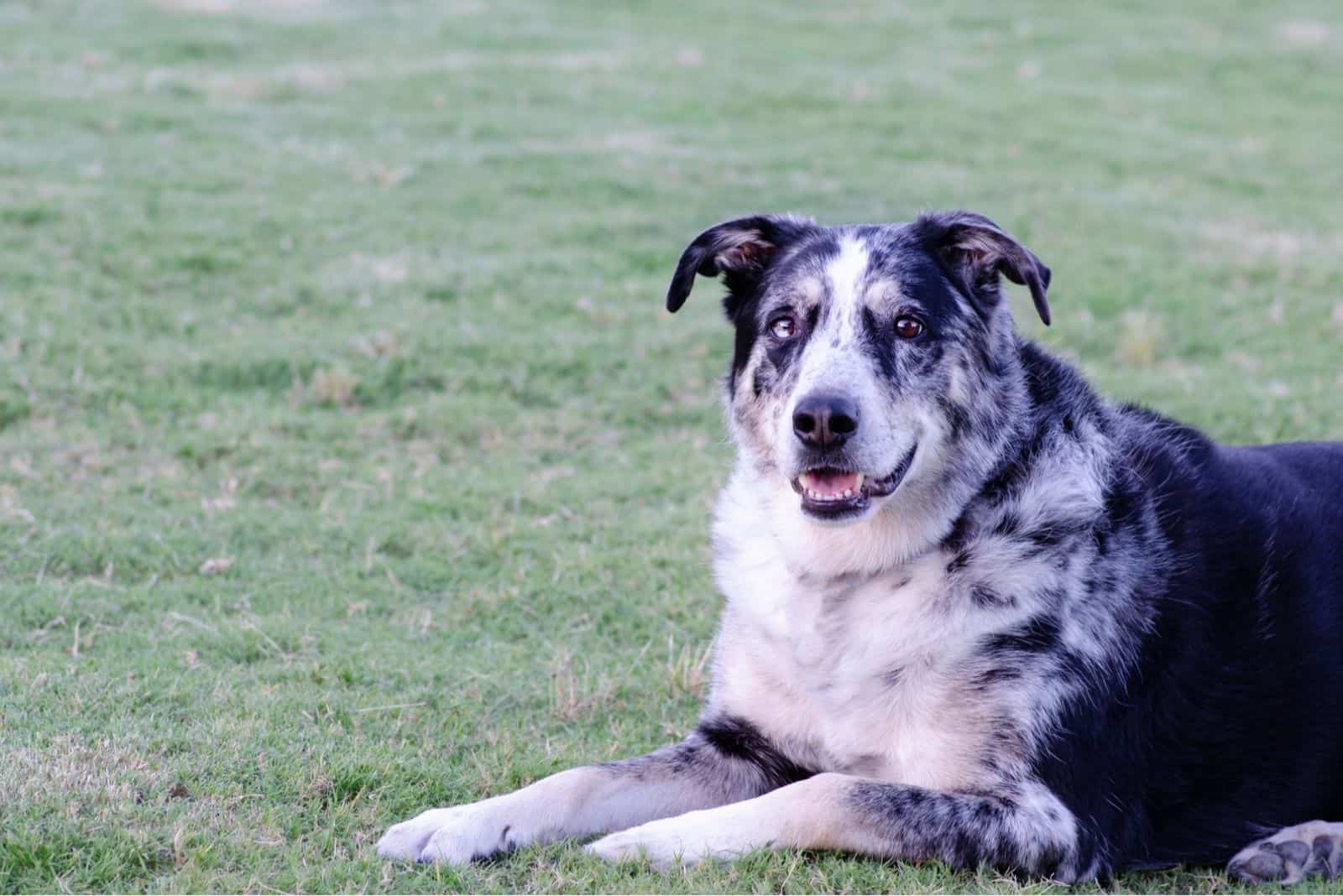
So, what should we expect from the hybrid of these two?
Well, it’s likely to be a medium- to large-sized dog, athletic and muscular, and with bags of energy. We’ll come to its size later, but for now, we’ll focus on its looks.
Guessing its coat color will be difficult, and you’ll have to wait a few months to find out its true color. There’s a good chance that it will have the multicolored coat of the Aussie Shepherd, but much will depend on the parents’ colors.
You might have a pup that looks very much like the GSD, but with a light coat and random splashes of black, or a mixture of silver, blue, white, and tan. Then again, your pup could look more like a Collie-type dog, but with the classic black and tan coat of the German Shepherd.
Alternatively, you might get a completely black dog, possibly with touches of gray or silver at the tips. The anticipation and uncertainty are all part of the fun! One thing is for certain: your pup will be unique.
Eye color is equally unpredictable, as the pup may inherit the heterochromia gene from the Aussie parent. However, you might believe that your German Shepherd Australian Shepherd mix pup has blue eyes when you first see him, but as all pups have blue eyes when they are born, you could be disappointed when they start to turn a darker shade a few weeks later.
As for the ears, they’re probably going to flop down like the Aussie dog. But, there is a chance that they’ll be upright and triangular just like the GSD. Even so, they will be rounded at the tip rather than pointed, giving your pup a softer look.
How Big Will A German Shepherd Australian Shepherd Mix Get?
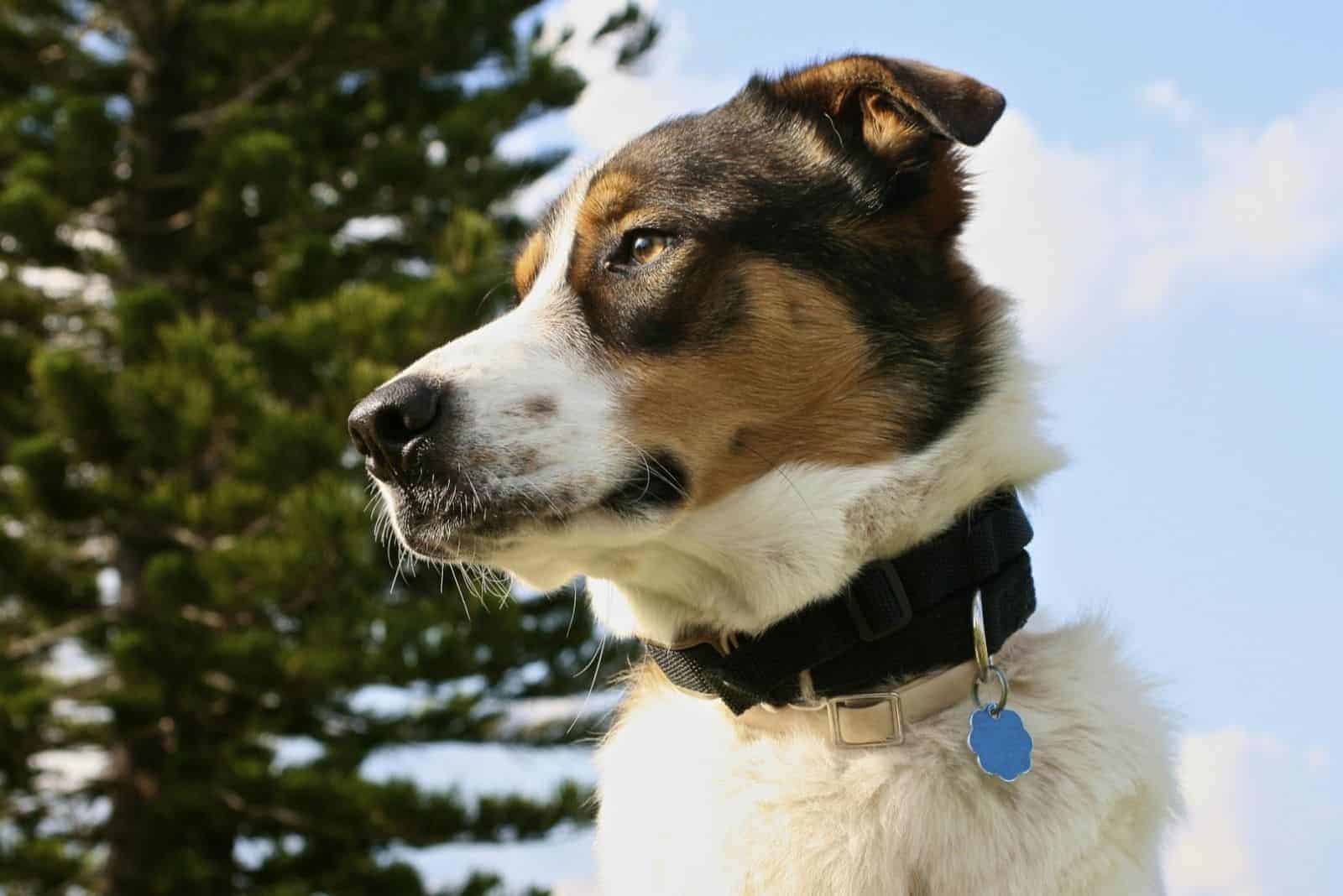
Going purely on existing examples, we can suggest a weight range of between 45 and 80 pounds, and a height of between 19 and 26 inches. As always, the females will be at the lower end of this scale.
This means that your German Shepherd Australian Shepherd mix will be a fairly big dog. When combined with the fact that they are seriously energetic, you’ll need a lot of space to look after them properly. These are not apartment or city dogs. They need to run and play as much as possible or they will become depressed, frustrated, and possibly aggressive.
We’ll talk more about aggression further along.
German Shepherd Australian Shepherd Mix Cost
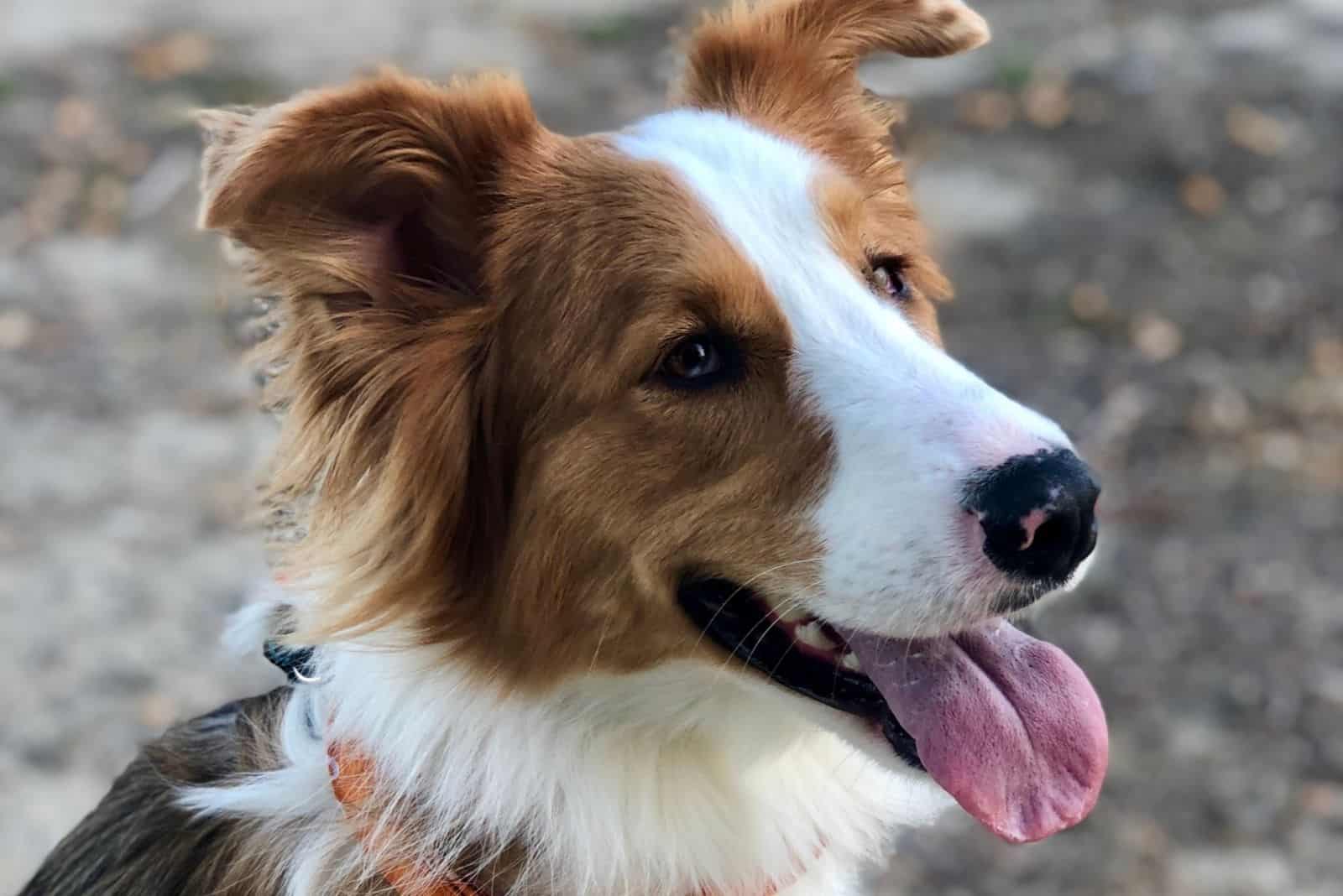
You can find German Shepherd Australian Shepherd mix puppies for between $500 and $2,000.
Yes, that’s a big difference, isn’t it?
The reason for this is that some breeders are well-established and have pedigree dogs in their kennels. Breeding is an expensive business, and few breeders make any profit at all. In fact, it’s usually the reverse.
Pedigree pups are regarded as being of higher quality (but, let’s not forget, every pup is a precious life and could never be classed as poor quality!) and this allows the breeder to sell them at premium prices. If you can find a decent, reputable breeder, then there’s no reason why you shouldn’t buy a $500 pup as long as it is happy and healthy.
The best advice is to set a budget, and do some homework on the breeders in your area. Kennel clubs will hold lists of trusted breeders, and even if they don’t produce the German Australian Shepherd puppies, they may be able to point you towards a reputable breeder who does.
Do Australian German Shepherds Shed?
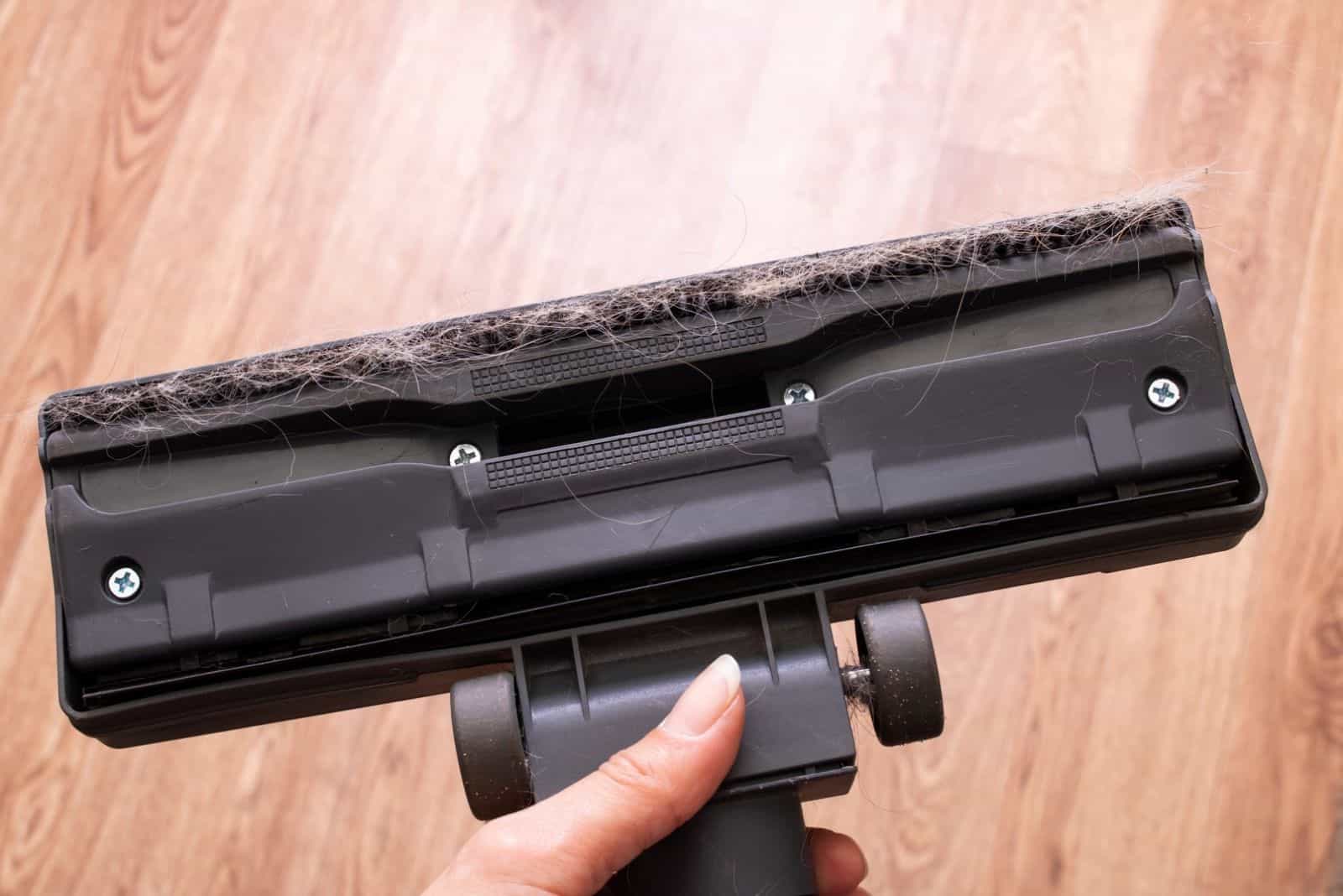
Yes. Like all dogs, this mixed breed sheds hair.
Both parent breeds are moderate shedders that blow their coats in spring and fall. They also both have medium-length double coats that have a rough topcoat of guard hairs and a soft furry undercoat. It is this fur that falls out in ridiculously large amounts twice a year.
The Australian German Shepherd mix follows this example, dropping masses of fur in the shedding seasons. You’ll need to brush them every day just to keep this under control unless you want a house full of fluff!
Vacuuming regularly is a good idea, as this fur is very light and will swirl around, particularly on laminate or tiled floors. What doesn’t stick to rugs, sofas, and clothes will make its way into other rooms, even onto your dinner.
Outside of the shedding seasons, you should brush your GSD Aussie mix at least once a week (ideally two or three times a week) to get rid of loose hair and tangles. Knots in a dog’s fur can be painful as they can catch on obstacles and pull the skin. They also trap dirt that contains bacteria, which increases the risk of infection.
One question that often arises concerning different dog breeds is whether or not they are hypoallergenic. This is important if you or someone in your family has allergies.
Unfortunately, neither of the parent breeds is regarded as hypoallergenic, so it’s unlikely that the crossbreed of these two will be.
However, there is no such thing as an allergy-free dog. This is not what hypoallergenic means. It’s simply a way of saying that a dog is less likely to cause an allergic reaction than some other breeds!
In the case of the German Shepherd Australian Shepherd mix, there’s a chance that it will produce a lot of dander, which is one of the main causes of allergic reactions to dogs. Proteins in the dog’s dander and saliva are what we are allergic to, not the hair or fur itself.
These stick to the dog’s hair, which eventually fall out. In some cases, you can cut the risk of an allergic reaction by keeping the dog’s skin healthy, and by brushing them regularly to stop loose hair from falling around your home.
If you really love the Aussie Shepherd, but are concerned about allergies, you might want to check out the Aussiedoodle; a fantastic mix of the Aussie Shepherd and the Poodle, which may just have the Poodle’s hypoallergenic coat.
Are German Australian Shepherds Aggressive?
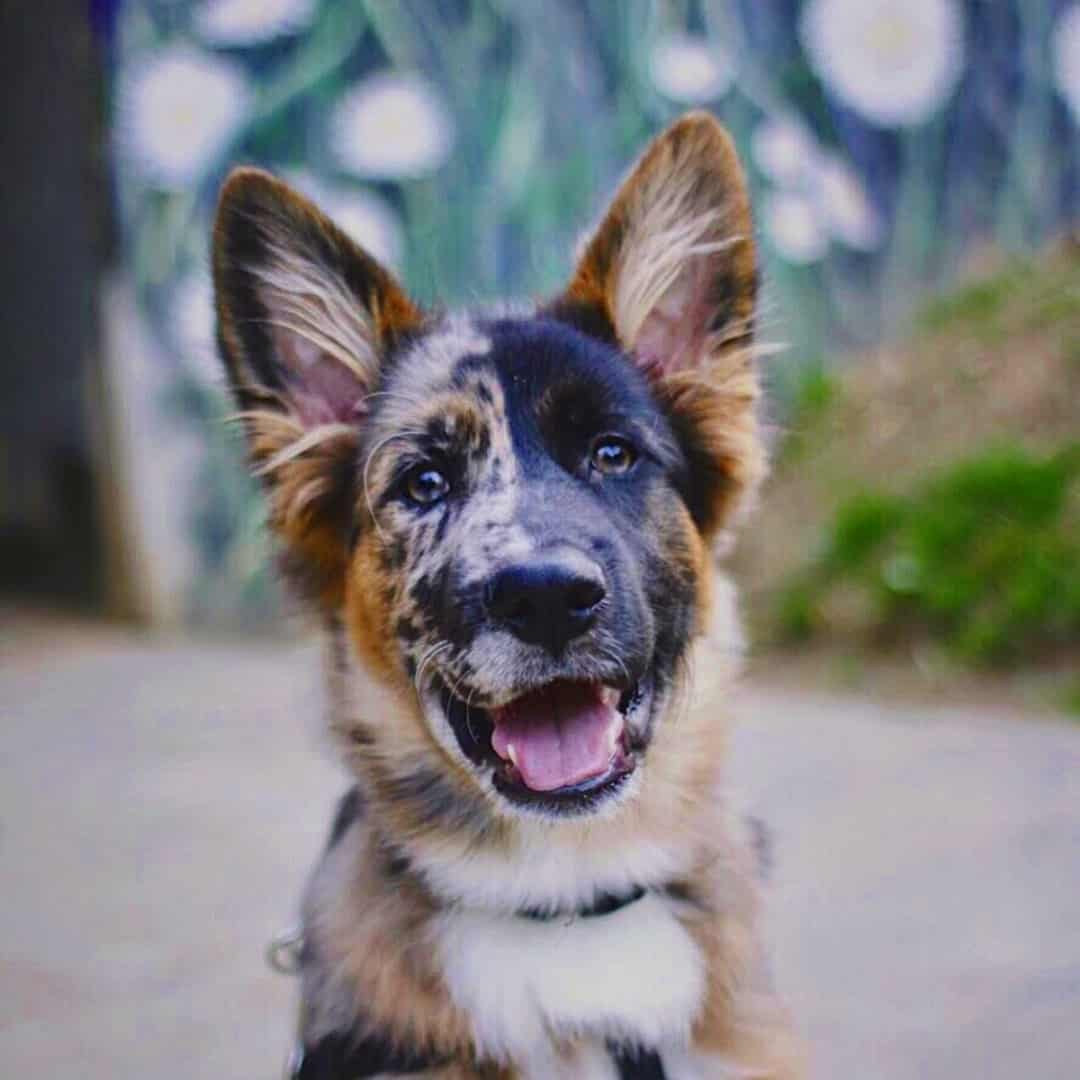
Photo from: @k9universal
We need to look to the parent breeds again for the answer to this question.
The Aussie Shepherd is not typically an aggressive breed. It can be protective at times, and it has strong herding instincts, but they are generally good-natured and safe around children.
The German Shepherd can be trained to be aggressive when given a command, but it is typically a calm and obedient dog. It is also considered safe around children, but early socialization is always wise, and kids should never be left alone with dogs, just as a precaution.
So, what does this mean for the German Shepherd Australian Shepherd mix?
The truth is that it’s difficult to predict the exact nature of a crossbreed as it can inherit traits from one parent more than the other. All we can do is look at the examples available and try to draw some conclusions from them.
So far, it looks as if the German Shepherd Aussie mix is a guard dog and a nanny! It will watch out for you and your family, alerting you of any danger, and it will love and protect any young child.
Aggression does not seem to be a problem, especially not towards the owner and their family. Any sign of aggression will probably be directed at strange dogs that appear to present a threat.
Once again, socialization is the key to reducing this behavior and getting your dog used to being around other animals.
One final thing to keep in mind is that any dog can be aggressive if it isn’t cared for properly. If they are sick, in pain, fearful, or mistreated, even the most placid dog can turn very nasty and become very aggressive.
Conversely, dogs that appear to be extremely aggressive can become the softest and most affectionate furballs you will ever meet if they are shown love and care.
German Shepherd Australian Shepherd Mix Health Problems
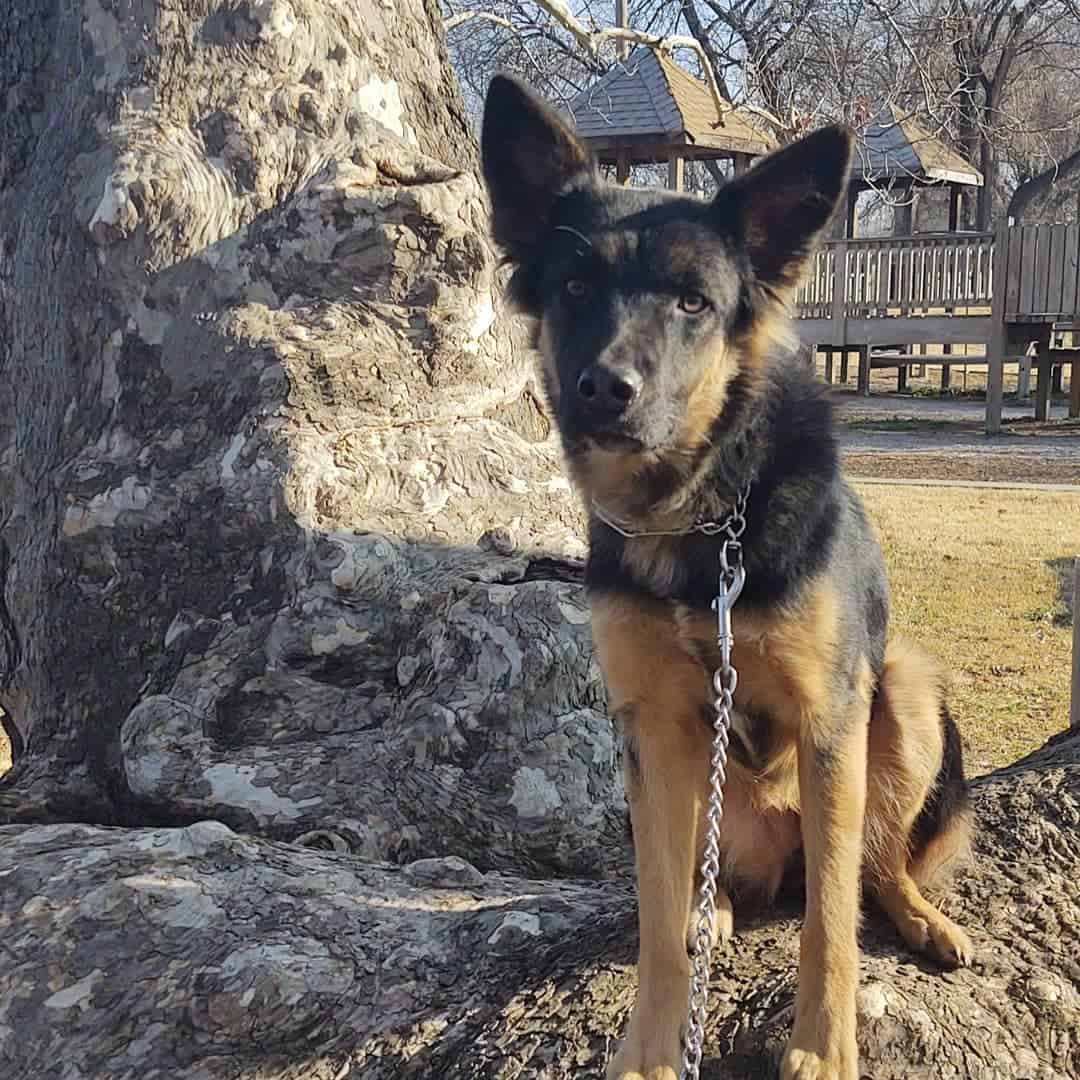
Photo from: @debzadraws
Inevitably, there will sometimes be the odd medical issue to deal with. These will hopefully be minor and dealt with quickly and easily. However, you should be aware of any potentially serious health condition so that you can be prepared.
These are a few of the health issues that you might encounter with the German Shepherd Australian Shepherd mix:
• Degenerative myelopathy – A disease of the spinal cord that stops the brain from communicating with the hindquarters. It is a progressive disease that almost always results in complete paralysis of the back legs. In many cases, their front legs are weakened and they become incontinent. The only good news is that this disease is not painful.
• Hemophilia – An inherited condition that stops blood from clotting. Dogs with this condition can have prolonged, spontaneous bleeding from injuries, or even from the nose and eyes.
• Elbow dysplasia – A malformed elbow joint can be painful, becoming inflamed and sore, and leading to arthritis in old age. Surgery is usually required for severe cases.
• Hip dysplasia – A similar condition to the one above, but affecting the hip joints instead.
• Epilepsy – Seizures can be caused by trauma or sickness, but in many cases, the real reason is unknown. This is referred to as idiopathic epilepsy, and it is usually managed with lifelong medication to control it.
• Cataracts – There are several reasons why dogs can get this condition, which is a change in the lens that causes cloudiness and impairs the dog’s vision. Your vet may prescribe eye drops to reduce inflammation, but surgery to remove the cataract is the most effective treatment.
• Bloat – Also known as Gastric Dilatation-Volvulus (GDV), this condition can be fatal. It usually occurs after the dog has eaten or drank excessively, often just before or after exercise. The stomach starts to fill up with gas, then twists around on itself, cutting off the blood supply to the organs and rupturing the stomach lining. Without emergency surgery, the dog will not survive. Deep-chested breeds, such as the GSD are prone to this condition, which possibly puts this designer dog at risk.
• Collie eye anomaly – This is actually a group of eye problems affecting Collie-type breeds. They range from mild to potentially fatal, and some can cause blindness in one or both eyes. It is vital that your dog is checked regularly for any sign of eye problems of this nature. Reputable breeders will screen their dogs for this to reduce the chances of it being passed on to the pups.
These conditions are common among purebred dogs of all kinds, but it is widely believed that by crossing two breeds, the risk of inherited diseases is reduced.
This means that your German Shepherd Australian Shepherd mix has a good chance of avoiding these unpleasant conditions. Even so, it’s always best to keep an eye out for any telltale sign, and get your dog checked out by the vet on a regular basis.
German Australian Shepherd Mix Lifespan
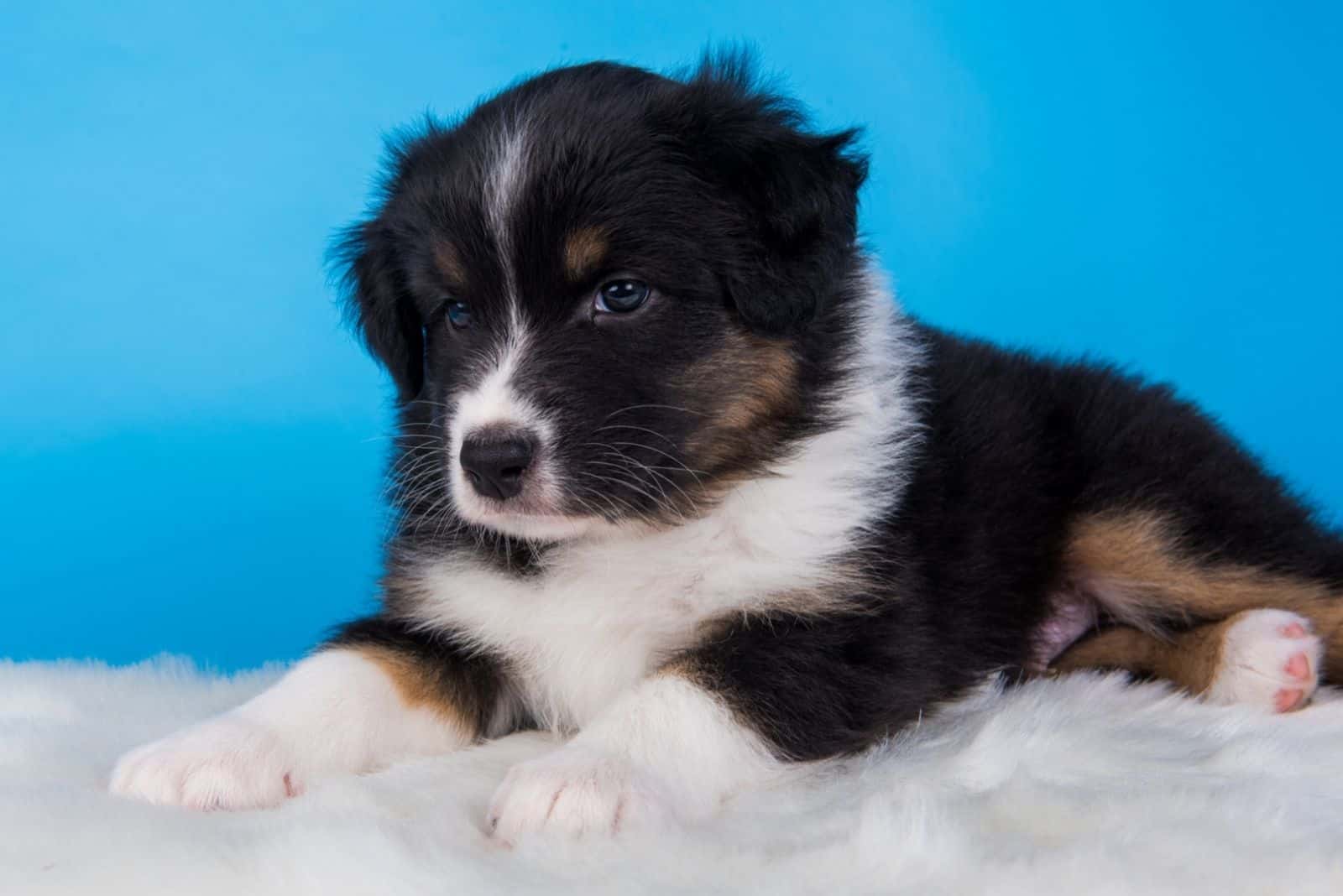
When you get your adorable pup home, the last thing on your mind is that fateful day when your loyal doggy friend leaves you to cross the rainbow bridge.
It’s a sad fact of owning a dog that they often lead such tragically short lives. Because of this, it’s always good to have an idea of how long you can expect them to be around, even if it’s just a rough idea that you store in the back of your mind while you enjoy their company.
So, what about the German Shepherd Australian Shepherd mix? How long do they usually live?
When you look at the parents, you might be alarmed to discover that the AKC puts the German Shepherd’s lifespan at 7 to 10 years. Seven years! That seems tragically short.
This is believed to be a result of selective breeding, which has produced a range of genetic faults that cause health problems. While they aren’t fatal in themselves, they affect the dog’s quality of life, forcing owners to euthanize their beloved pets to stop their suffering.
As for the Aussie Shepherd, this dog enjoys a life expectancy of between 12 and 15 years, which is better.
But, what about the hybrid of these two? Does it mirror the GSD or take after the Aussie side?
As this is a designer dog, they can’t be registered with kennel clubs (yet!) so reliable records are difficult to obtain.
Even so, from the data available, it is suggested that the German Shepherd Australian Shepherd mix could live for between 13 and 15 years.
To go further, because this is a hybrid, there’s a strong possibility that any genetic fault won’t be passed down the line to the pups. Subsequent generations could be much healthier than the original parent breeds because of the fresh injection of genes.
The scientific name for this process is hybrid vigor, and it could well help these dogs to exceed the upper limit of 15 years in the future.
In the meantime, you can help to stretch this limit by getting a healthy pup in the first place. Choose your breeder wisely! Then, once you get your pup, feed it the best quality dog food, and never be tempted to overfeed it or be too generous with unhealthy treats. You may think that you are showing them love, but in fact, you may be shortening their lives.
Human foods are packed with salt, sugar, fats, and chemicals that can harm your dog, even in small amounts.
Obesity causes real problems, putting extra strain on the heart and the joints, and often resulting in diabetes and heart disease.
A balanced diet and plenty of exercise are the two best things for your pooch. Get these right and you’ll significantly increase your dog’s chances of a long life.
The Aussie German Shepherd – The Perfect Family Dog?
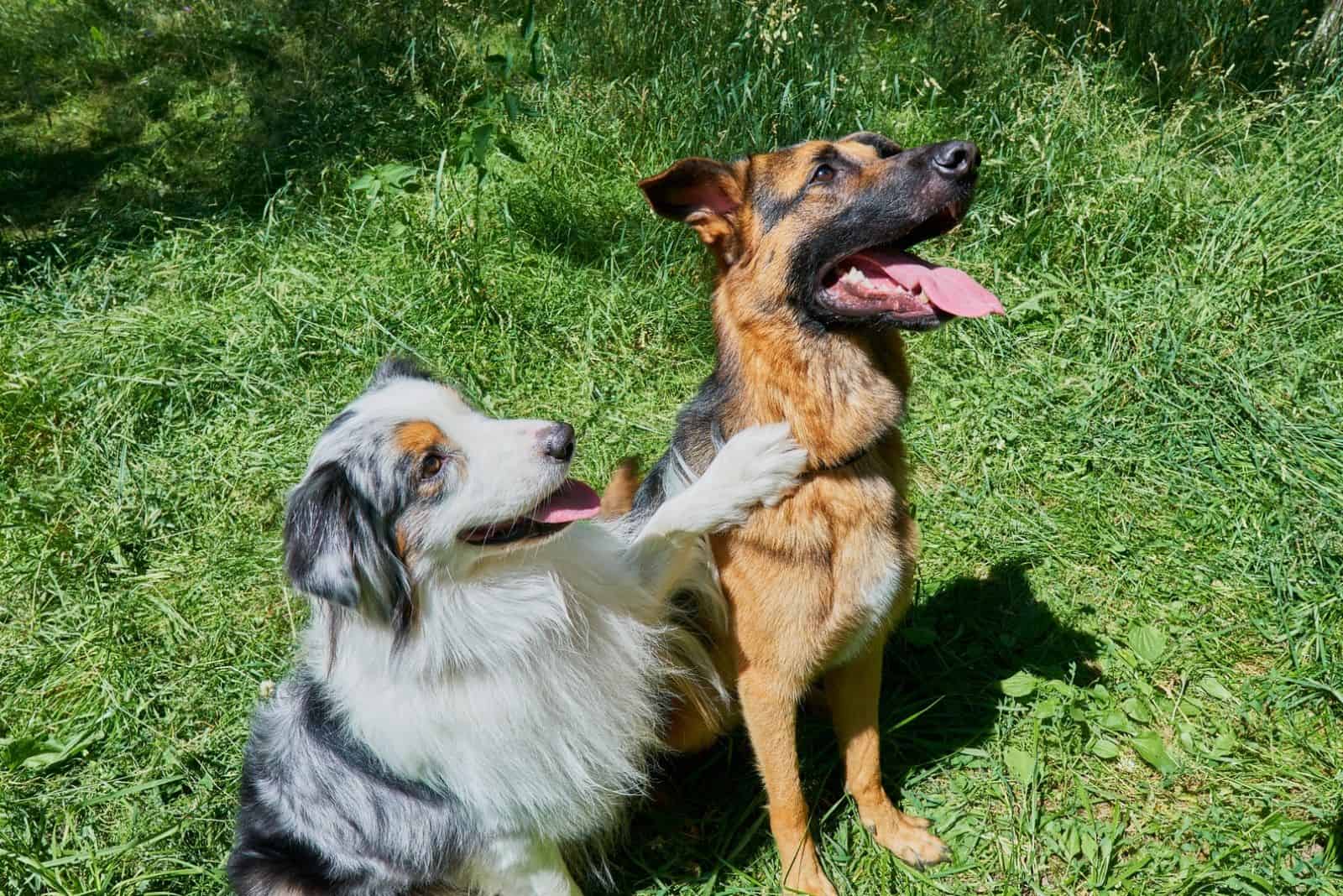
For an active family, this is indeed the perfect dog. It is loyal, affectionate, good-natured, and obedient.
That’s not to say that it isn’t a good dog for singles or couples; just that these dogs are suitable for families with small kids.
The main consideration is that you have a lot of space; perhaps a large garden or fields and woods where your dog can run. These dogs have very high energy levels and will need lots of exercise. We’re talking about at least two hours every day, rain or shine.
That means long walks and a good run, playtime, and swimming (although the GSD side might make them hesitant to enter the water). They will love activities like flyball, dock diving, agility courses, herding competitions, problem-solving, obstacle races, etc. as these provide mental stimulation as well as physical exercise.
Whether you decide to go for these or not, it is essential that you enroll your pup in obedience training. These dogs are super-smart, and they need direction or they will make up their own rules. One thing in your favor is that they love to learn and they really want to make you happy. Training is something that will be rewarding for you both!
Your pup will not enjoy being left alone for long periods, and they will let you know it by barking excessively, chewing up your home, and digging up your garden or back yard.
On a cautionary note, you might need to be careful if you have small pets or even a cat. These dogs may have a high prey drive, and might chase small animals. They may even harm them. Once again, socialization is the very best way of dealing with this.
Some experts recommend that this process is started when the pup is only 2.5 weeks old! As most breeders don’t release their pups until they are at least 6 weeks old (and often between 8 and 12 weeks old), then you must begin the process immediately.
Some of the best breeders actually start socializing their pups for you, which is a real help!
Your pooch is likely to have a medium-length coat that sheds a fair bit. This will need brushing two or three times a week to get rid of dead hair and keep the coat in good condition.
Brushing distributes natural oils that coat the hairs, and this gives them a healthy, glossy shine. This also protects the coat from the elements and stops it from becoming dull.
As much as it loves and adores family members, the German Shepherd Australian Shepherd mix can be reserved and aloof with strangers. It is also very alert and will warn you when it senses danger, which makes it an excellent watchdog.
To help it discern the difference between a threat and a welcomed guest, you should ensure that your pup has proper socialization, as mentioned earlier (several times).
So, yes, they make fantastic family pets. Some may even say that they are the perfect family dog. But, you have to do your bit!
Read Next:
• Australian Shepherd Rottweiler Mix: Beauty And Brawn
• Pitbull Australian Shepherd Mix: Meeting Your New Buddy
• Have A Merry Australian Shepherd Beagle Mix — It’s Bark Time
